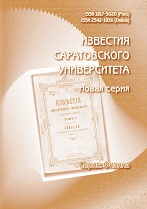|
Biophysics and Medical Physics
Features of photo-stimulated adsorption of enzymes on semiconductor substrate
A. V. Kozlowski, S. V. Stetsyura
Saratov State University
Abstract:
Background and Objectives: Features of photostimulated adsorption of enzymes on a semiconductor substrate, leading to different changes in the sensitivity to glucose and hydrogen peroxide, were studied using the enzymes glucose oxidase and horseradish peroxidase as an example. Materials and Methods: Enzyme molecules were deposited on n-Si and p-Si substrates by photostimulated layer-by-layer adsorption from solution. Glucose oxidase and horseradish peroxidase were used as enzymes. The resulting structures were mounted in an electrochemical cell to measure the capacitance-voltage characteristics of the electrolyte-insulator-semiconductor contact, which were then used to determine the sensitivity of the sensor structures to glucose and hydrogen peroxide. Results: The results were analyzed taking into account photoelectronic processes in n-Si and p-Si semiconductor substrates. An increase in the sensitivity to the analyte from the use of photostimulated adsorption has been found for the structures obtained on the basis of n-Si, regardless of the type of immobilized enzyme. But for glucose oxidase molecules, the effect of photostimulation reaches 200%, and for horseradish peroxidase molecules it does not exceed 30%. The effect of photostimulated adsorption is explained by the charge exchange of surface electronic states at the Si/SiO2 interface upon illumination and the formation of induced dipoles that combine the charge of the enzyme molecule and the opposite charge of the Si/SiO2 interface after the illumination is turned off. Conclusion: The conducted studies can be applied in the development of a capacitive biosensor operating on the field effect, since taking into account the change in the charge state of the immobilized enzyme and the surface of the semiconductor signal converter makes it possible in some cases to significantly increase the sensitivity of the biosensor.
Keywords:
silicon, polyelectrolyte, photo-stimulated adsorption.
Received: 29.06.2023
Citation:
A. V. Kozlowski, S. V. Stetsyura, “Features of photo-stimulated adsorption of enzymes on semiconductor substrate”, Izv. Sarat. Univ. Physics, 23:4 (2023), 316–327
Linking options:
https://www.mathnet.ru/eng/isuph499 https://www.mathnet.ru/eng/isuph/v23/i4/p316
|

| Statistics & downloads: |
| Abstract page: | 42 | | Full-text PDF : | 23 | | References: | 22 |
|




 Contact us:
Contact us: Terms of Use
Terms of Use
 Registration to the website
Registration to the website Logotypes
Logotypes









 Citation in format
Citation in format 